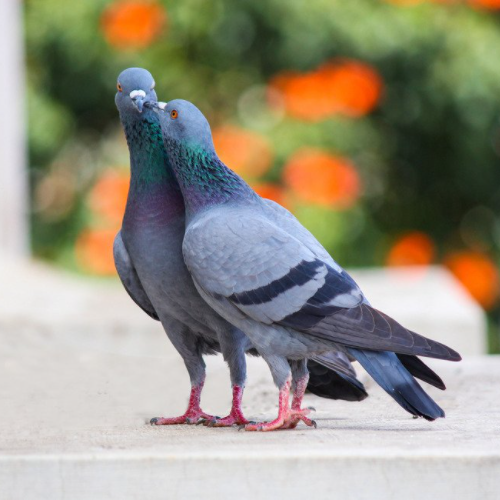
Pigeons are everywhere, so much so that we have become accustomed to seeing them without looking. Yet they exhibit a number of interesting behaviors. One of them, rare in the animal world but common among birds, is monogamy.
Pigeons are monogamous; they mate for life. But beware: monogamy does not exclude infidelity! Since the late 1980s, DNA-based techniques have allowed researchers to perform paternity tests on broods… and there are surprises. This is so true that it seems necessary to distinguish the concepts of social monogamy and genetic monogamy. Social monogamy is when a couple raises a family alone. Genetic monogamy, which can be assessed by DNA testing, is the fact that the male and female are the biological parents of the young they are raising. It is understood that social monogamy does not necessarily imply genetic monogamy.
Like pigeons, birds are mostly socially monogamous. Studies have been conducted on several hundred species of socially monogamous birds. In 76% of the species, researchers have detected deviations from genetic monogamy. These are not anecdotal: in species where genetic monogamy is not respected, an average of 19% of the chicks have a distinct social father and a genetic father.
There have not been many studies specifically devoted to genetic monogamy in pigeons. However, it is clear that infidelity is rare in pigeons, but it does exist. In response, male pigeons use two strategies to ensure paternity: frequent copulations and intense surveillance of their partner. This is all the more justified from an evolutionary point of view as they are considerably involved in the care of their young.
In cities, pigeons nest in building cavities. The female usually lays two eggs. These are incubated for about two weeks, usually by the male during the day and the female at night. After hatching, both parents feed the young with “pigeon’s milk”, a highly nutritious substance produced in their crop (a growth in the birds’ esophagus). The squabs are first fed exclusively on milk and then on a mixture of milk and seeds. The young feed by sticking their beaks down their parents’ throats, which induces regurgitation. After only one month, they begin to fly and, a week later, they abandon the nest. By this time, they have already reached their adult size – that’s why you never seem to see young pigeons in the streets. A couple can raise up to six broods per year.
As we have seen, pigeons mate for life. When one of the two members of the couple dies, the survivor sometimes shows signs comparable to those of depression and accepts a new mate only with great difficulty.
A certain reserve is necessary when dealing with this kind of question: we cannot measure feelings in humans, let alone in animals. However, it should be noted that evolution is conservative; it shapes the diversity of living beings from common biological elements. As far as emotions are concerned, there is no reason to think that we, humans, would possess something totally new and built from scratch. Indeed, the biological substrates of love are evolutionarily ancient. Oxytocin and vasopressin, the “love hormones” in humans, have almost identical analogues in birds. Birds also possess the basic neurotransmitters of the reward system, serotonin and dopamine. Moreover, the neurological structures that process signals associated with the feeling of love in humans evolved early in the history of animal life, long before the cerebral cortex itself.
Monogamy is the normal behavior of pigeons, which are among the most faithful birds. In this evolutionary context, the ability to experience love becomes meaningful. Monogamous couples share food, information and parental responsibilities, especially when, as in pigeons, the young require constant care. Love, by enhancing cooperation between the couple, should increase the chances of raising healthy offspring. Monogamy thus seems to be a fertile ground for the evolution of love.
Thus, the evolution of love in pigeons appears both structurally possible and desirable in terms of selective advantage. The scientific reasoning can hardly go further, but it is supported by abundant individual observations.
Here is one to conclude. About 15 years ago, Rita McMahon, who later founded the New York Wild Bird Fund, found a female pigeon with a broken leg on a bridge. A veterinarian had to amputate the leg. During her recovery, the pigeon lay on a cushion outside a window in McMahon’s apartment. Outside, on the other side, was her companion, who kept her company, day after day, until she was released and the couple could be reunited.

